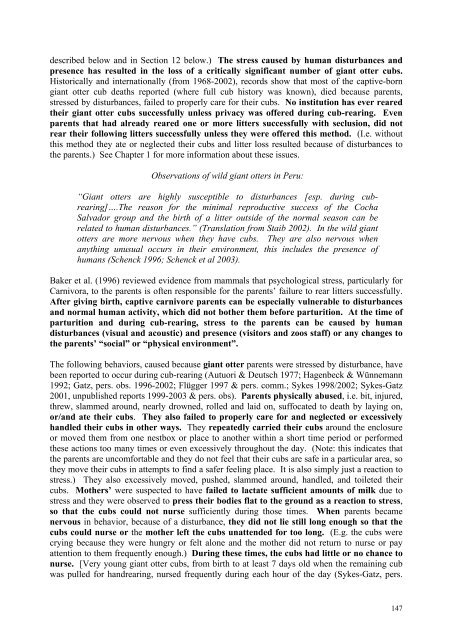International Giant Otter Studbook Husbandry and Management
International Giant Otter Studbook Husbandry and Management
International Giant Otter Studbook Husbandry and Management
You also want an ePaper? Increase the reach of your titles
YUMPU automatically turns print PDFs into web optimized ePapers that Google loves.
described below <strong>and</strong> in Section 12 below.) The stress caused by human disturbances <strong>and</strong><br />
presence has resulted in the loss of a critically significant number of giant otter cubs.<br />
Historically <strong>and</strong> internationally (from 1968-2002), records show that most of the captive-born<br />
giant otter cub deaths reported (where full cub history was known), died because parents,<br />
stressed by disturbances, failed to properly care for their cubs. No institution has ever reared<br />
their giant otter cubs successfully unless privacy was offered during cub-rearing. Even<br />
parents that had already reared one or more litters successfully with seclusion, did not<br />
rear their following litters successfully unless they were offered this method. (I.e. without<br />
this method they ate or neglected their cubs <strong>and</strong> litter loss resulted because of disturbances to<br />
the parents.) See Chapter 1 for more information about these issues.<br />
Observations of wild giant otters in Peru:<br />
“<strong>Giant</strong> otters are highly susceptible to disturbances [esp. during cubrearing]….The<br />
reason for the minimal reproductive success of the Cocha<br />
Salvador group <strong>and</strong> the birth of a litter outside of the normal season can be<br />
related to human disturbances.” (Translation from Staib 2002). In the wild giant<br />
otters are more nervous when they have cubs. They are also nervous when<br />
anything unusual occurs in their environment, this includes the presence of<br />
humans (Schenck 1996; Schenck et al 2003).<br />
Baker et al. (1996) reviewed evidence from mammals that psychological stress, particularly for<br />
Carnivora, to the parents is often responsible for the parents’ failure to rear litters successfully.<br />
After giving birth, captive carnivore parents can be especially vulnerable to disturbances<br />
<strong>and</strong> normal human activity, which did not bother them before parturition. At the time of<br />
parturition <strong>and</strong> during cub-rearing, stress to the parents can be caused by human<br />
disturbances (visual <strong>and</strong> acoustic) <strong>and</strong> presence (visitors <strong>and</strong> zoos staff) or any changes to<br />
the parents’ “social” or “physical environment”.<br />
The following behaviors, caused because giant otter parents were stressed by disturbance, have<br />
been reported to occur during cub-rearing (Autuori & Deutsch 1977; Hagenbeck & Wünnemann<br />
1992; Gatz, pers. obs. 1996-2002; Flügger 1997 & pers. comm.; Sykes 1998/2002; Sykes-Gatz<br />
2001, unpublished reports 1999-2003 & pers. obs). Parents physically abused, i.e. bit, injured,<br />
threw, slammed around, nearly drowned, rolled <strong>and</strong> laid on, suffocated to death by laying on,<br />
or/<strong>and</strong> ate their cubs. They also failed to properly care for <strong>and</strong> neglected or excessively<br />
h<strong>and</strong>led their cubs in other ways. They repeatedly carried their cubs around the enclosure<br />
or moved them from one nestbox or place to another within a short time period or performed<br />
these actions too many times or even excessively throughout the day. (Note: this indicates that<br />
the parents are uncomfortable <strong>and</strong> they do not feel that their cubs are safe in a particular area, so<br />
they move their cubs in attempts to find a safer feeling place. It is also simply just a reaction to<br />
stress.) They also excessively moved, pushed, slammed around, h<strong>and</strong>led, <strong>and</strong> toileted their<br />
cubs. Mothers’ were suspected to have failed to lactate sufficient amounts of milk due to<br />
stress <strong>and</strong> they were observed to press their bodies flat to the ground as a reaction to stress,<br />
so that the cubs could not nurse sufficiently during those times. When parents became<br />
nervous in behavior, because of a disturbance, they did not lie still long enough so that the<br />
cubs could nurse or the mother left the cubs unattended for too long. (E.g. the cubs were<br />
crying because they were hungry or felt alone <strong>and</strong> the mother did not return to nurse or pay<br />
attention to them frequently enough.) During these times, the cubs had little or no chance to<br />
nurse. [Very young giant otter cubs, from birth to at least 7 days old when the remaining cub<br />
was pulled for h<strong>and</strong>rearing, nursed frequently during each hour of the day (Sykes-Gatz, pers.<br />
147

















